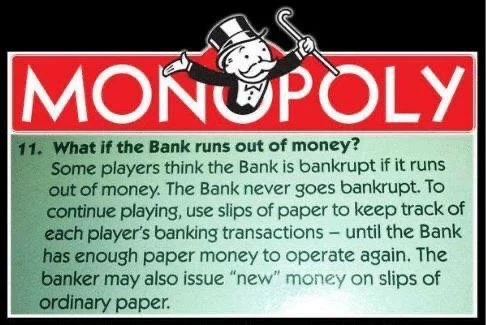What Do Banks Own?
Banks are supposed to have money. Starting in March (a year after the Federal Reserve began raising interest rates), the banks Silicon Valley Bank, Signature Bank, Credit Suisse, and First Republic were bought and bailed out. On July 25, the Banc of California bought out Pacific Western Bank. What do banks own if they need money?
Silicon Valley Bank went bust on Friday, March 10, 2023. On March 12, Signature Bank went bust. The Federal Reserve, the Treasury, and the FDIC issued a joint statement saying that they would protect most of the money.[1]
Credit Suisse was bailed out by the Swiss National Bank via UBS (formerly known as Union Bank of Switzerland) on March 19.[2]
On May 1, First Republic was bailed out by the Federal Deposit Insurance Corporation (backed by the Federal Reserve), and bought by JP Morgan.[3]
Yesterday, July 25, 2023, the Banc of California bought out Pacific Western Bank. Was Pacific Western Bank on the verge of insolvency?
Via Niket Nishant and Nupur Anand writing for Reuters,[4]
“July 25 (Reuters) - Banc of California (BANC.N) and PacWest Bancorp (PACW.O) will merge in an all-stock deal to create a bank with $36 billion in assets, the companies announced on Tuesday.
[…]
Shares of PacWest plunged 27%, while Banc of California surged 10% after the Wall Street Journal reported news of a potential deal, citing people familiar with the matter.
PacWest was among the lenders that was rocked by the collapse of three regional banks earlier this year, prompting the worst industry turmoil since the 2008 financial crisis.”
What do the banks own? Bonds and real estate are traditional bank investments. Banks are sitting on unrealized losses from the bonds that they own and many are invested in commercial real estate that is not doing well.
Bonds are supposed to be a safe haven. However, if one had bought a bond for $100 at 1% interest, when trying to sell the bond, someone may see that there is another $100 bond for sale that yields 5% interest. If the bond buyer is willing to buy the 5% bond for $100, they would likely want to buy the 1% bond for less than $100 because it is not as profitable. That means that since the Federal Reserve started raising interest rates again in March 2022, bond sellers (bankers) will have to sell their bonds for less than they were bought when interest rates were low. They will realize the loss when they sell, until then, it is an “unrealized loss.”
Basically, banks have less money than they claim.
How Interest Rates Work: https://www.hamiltonmobley.com/blog/printing-money-lowers-interest-rates
Via the Kansas City Federal Reserve, published April 11, 2023,[5]
“Interest rates have risen across the yield curve since the Federal Open Market Committee began tightening monetary policy in March 2022. After amassing securities during the pandemic, commercial banks saw rising interest rates erode the value of their securities portfolios by nearly $600 billion, or about 30 percent of their capital holdings. In some cases, declines in valuation of securities holdings in response to interest rate changes—known as ‘unrealized losses’—can mechanically reduce key regulatory capital and liquidity ratios. Should banks need to sell the securities to generate income when their valuations are low, the realized losses could erode capital buffers and threaten the banks’ solvency.”
Commercial real estate is financed by banks. It is in serious trouble. The covid lockdowns killed businesses and introduced working from home. There isn’t enough business for the prices of the available office space. Many surviving businesses are dying from a lack of foot traffic as people stay away from downtowns. Many businesses districts are turning into Democrat ghettos like in Seattle, Washington; Portland, Oregon; Los Angeles, California; San Francisco, California; and Jackson, Mississippi.
Via Joy Wiltermuth, writing for Market Watch on July 24,[6]
“Big-time landlords have begun surrendering office buildings and other struggling properties to lenders this year, when just a few years ago they were fetching sky-high values amid super-low rates.
Many consider it the start of a reckoning for the estimated $20.7 trillion commercial real-estate market, likely its biggest test of confidence since the 2007-2008 global financial crisis.
Brian Lane, the Well Fargo Investment Institute’s lead analyst for private credit, pointed to a $1 trillion ‘wall of worry’ as a wave of commercial real-estate loans come due through the end of 2024 (see chart), in a Monday client note. The balance balloons to about $2.5 trillion through the end of 2027.
‘Property owners are facing higher vacancy, reduced net operating income, falling prices and rising capitalization rates,’ Lane wrote. ‘While valuations have started to decline in most property types, there is likely more downside.’
A recent McKinsey report pegged prices for office buildings as likely to fall as much as 42%,
Morgan Stanley analysts reiterated a call for overall commercial-property prices to drop 27.4% peak-to-trough through the end of 2024.”
Considering that banks have any exposure to bonds and commercial real estate, the real question is, “What does your bank own?” Have you done the research or do you just trust that it is solvent?
Banks are supposed to have money. Starting in March (a year after the Federal Reserve began raising interest rates), the banks Silicon Valley Bank, Signature Bank, Credit Suisse, and First Republic were bought and bailed out. On July 25, the Banc of California bought out Pacific Western Bank. What do banks own if they need money?
End Note: Today, the Federal Reserve raised the Federal Funds Rate to the range of 5.25% - 5.5% from 5% - 5.25%. LOL
[1]https://www.hamiltonmobley.com/blog/silicon-valley-bank
[2]https://www.hamiltonmobley.com/blog/bank-bailouts
[3]https://www.hamiltonmobley.com/blog/first-republic-goes-bust
[4]https://www.reuters.com/markets/deals/banc-california-talks-buy-pacwest-bancorp-wsj-2023-07-25/




